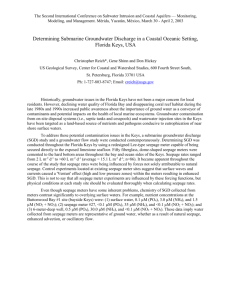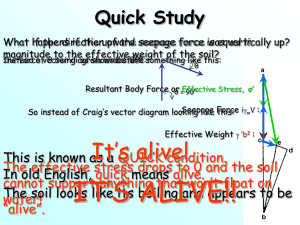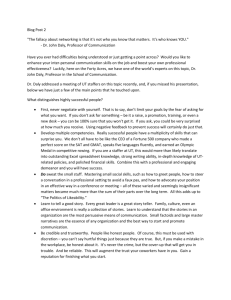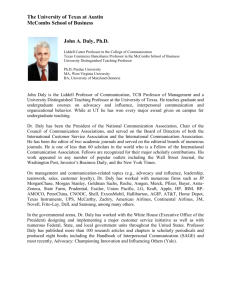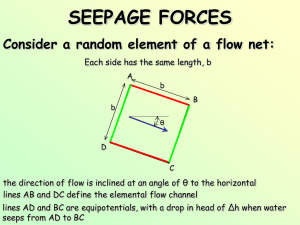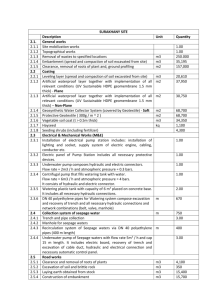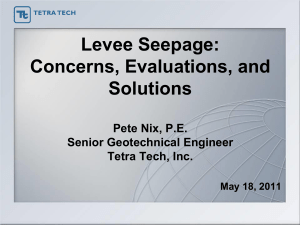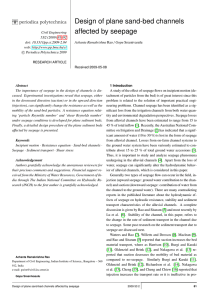Research consultancies - Department of the Environment
advertisement
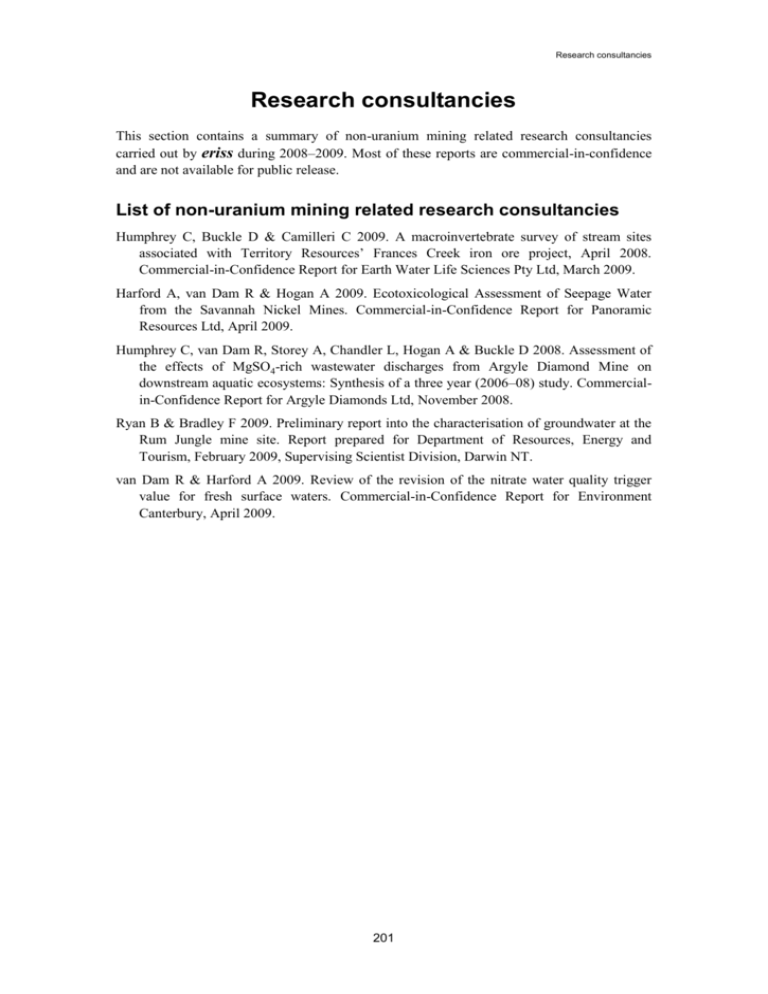
Research consultancies Research consultancies This section contains a summary of non-uranium mining related research consultancies carried out by eriss during 2008–2009. Most of these reports are commercial-in-confidence and are not available for public release. List of non-uranium mining related research consultancies Humphrey C, Buckle D & Camilleri C 2009. A macroinvertebrate survey of stream sites associated with Territory Resources’ Frances Creek iron ore project, April 2008. Commercial-in-Confidence Report for Earth Water Life Sciences Pty Ltd, March 2009. Harford A, van Dam R & Hogan A 2009. Ecotoxicological Assessment of Seepage Water from the Savannah Nickel Mines. Commercial-in-Confidence Report for Panoramic Resources Ltd, April 2009. Humphrey C, van Dam R, Storey A, Chandler L, Hogan A & Buckle D 2008. Assessment of the effects of MgSO4-rich wastewater discharges from Argyle Diamond Mine on downstream aquatic ecosystems: Synthesis of a three year (2006–08) study. Commercialin-Confidence Report for Argyle Diamonds Ltd, November 2008. Ryan B & Bradley F 2009. Preliminary report into the characterisation of groundwater at the Rum Jungle mine site. Report prepared for Department of Resources, Energy and Tourism, February 2009, Supervising Scientist Division, Darwin NT. van Dam R & Harford A 2009. Review of the revision of the nitrate water quality trigger value for fresh surface waters. Commercial-in-Confidence Report for Environment Canterbury, April 2009. 201 Research consultancies Ecotoxicological assessment of mine site seepage water A Harford, R van Dam, A Hogan & A Storey1 An ecotoxicological assessment was undertaken on seepage waters from a mining project in north-west Western Australia, to address knowledge gaps regarding potential effects of mine seepage waters on downstream aquatic ecosystems. The study was done in conjunction with a field study by Wetland Research and Management of the aquatic biota of the creeks on and adjacent to the mine. The objectives of the ecotoxicological study were to: 1 assess the toxicity of seepage water to five native tropical freshwater species; 2 compare the ecotoxicological results to water quality downstream of SNM in order to predict the risks of the aquatic ecosystems being impacted; and 3 where possible, recommend site-specific water quality Trigger Values (TVs) for key toxicants or water quality parameters based on the laboratory ecotoxicological results or approaches detailed by ANZECC/ARMCANZ (2000). The toxicity of the seepage water ranged from non-toxic to moderately toxic. Chemical analyses of the seepage water demonstrated that sulfate (SO4) and magnesium (Mg) were the major constituents. Metals were below default ANZECC/ARMCANZ (2000) guideline TVs. A likely cause of observed toxicity was the combination of all the elevated major ions, resulting in an ion imbalance that led to osmotic stress in the organisms (ie a salinity effect). As SO4 was the clearly dominant ion in the seepage water, and hence a good indicator of seepage water salinity, a preliminary TV for SO4 of 70 mg/L, based on the toxicity data, was proposed. Based on comparisons of the preliminary SO4 TV (ie as an indicator of the seepage water salinity) with existing limited environmental monitoring data, the risk of seepage water having a significant impact on the downstream aquatic ecosystem appeared to be low. The results of the field study confirmed this conclusion. There were no significant adverse effects observed on fish, zooplankton or hyporheic-zone fauna, and detectable but minor effects on macroinvertebrate communities, at mine-exposed sites. Moreover, the data obtained from the field study showed an ecological response consistent with the laboratory-derived SO4 TV of 70 mg/L for protection of more sensitive macroinvertebrate species. In the event the mining project wished to identify the cause/s of toxicity of the seepage water, additional toxicity studies were recommended, using a ‘synthetic’ seepage water that simulates the major ion composition and concentrations in the seepage water. Various manipulations of the synthetic effluent, whereby ions are excluded individually (and, if necessary, in combination), would aid in identifying the key major ion/s contributing to toxicity. References ANZECC/ARMCANZ 2000. Australian and New Zealand guidelines for fresh and marine water quality. National Water Quality Management Strategy Paper No 4, Australian and New Zealand Environment and Conservation Council & Agriculture and Resource Management Council of Australia and New Zealand, Canberra. 1 Wetland Research & Management, Glen Forrest, WA 6071, Australia 202 TRaCK 4.1 – Flood inundation mapping for the Mitchell and Daly River catchments R Bartolo, D Ward2 & D Jones TRaCK (Tropical Rivers and Coastal Knowledge) is a research hub under the Commonwealth Environmental Research Facilities (CERF) scheme, managed by the Department of Environment, Water, Heritage and the Arts. eriss is a project collaborator in Theme 4 (Material budgets- water, carbon, sediment and nutrients), Project 4.1 – catchment water budgets and water resource assessment. The project aims to start measuring and calculating the different elements of water budgets in three of the TRaCK focus catchments (Daly River – NT, Mitchell River – Queensland, and Fitzroy River – NT). The specific task eriss is contributing to Project 4.1 is flood inundation mapping for the Mitchell and Daly River catchments. Defining the extent of wet season inundation in floodplain and riverine environments is an important component of the annual catchment surface and groundwater budgeting process. In the past year, historical rainfall data for the Mitchell and the Daly catchments and discharge data for the Mitchell was analysed and 2009 was identified as a suitable year for the mapping of maximum inundation limit for both the Mitchell and Daly catchments. For both the Mitchell and Daly catchments, optical remote sensing imagery (MODIS and Landsat) were captured during the 2009 wet season, coincident with ALOS PALSAR ScanSAR scenes. Additional ALOS imagery covering the Daly River floodplain was acquired to compare PALSAR modes (ScanSAR, Polarimetric and Fine Beam Double imagery). Figure 1 shows basic visual imagery interpretation of a component of the ScanSAR data for the Daly River. This information will be used to produce inundation classifications using Geographic Object Based Image Analysis (GEOBIA) approaches. Figure 1 Visual interpretation of PALSAR (ScanSAR mode) image of a subset of the Daly River Floodplain (captured 8 March 2009) for the major cover types associated with inundation mapping 2 Australian Rivers Institute, Nathan Campus, Griffith University 170 Kessels Road, Nathan, QLD 4111 Australia

